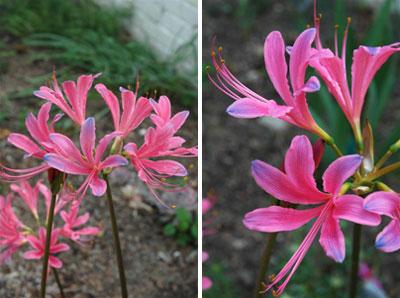
Plant of the Month: Lycoris haywardii
Lycoris haywardii
AT A GLANCE
Latin name: Lycoris haywardii
Common name: Electric surprise lily
Flowers: Clusters of bright pink, tipped with blue-purple
Mature size: Foliage to 12” and flowers to 24”
Spacing: 6”
Hardiness: Zones 6-9
Soil: Well-drained
Exposure: Late afternoon shade is best.
Water usage: Medium
Sources: www.brentandbeckysbulbs.com and www.bdlilies.com
You might be familiar with the spider lily (Lycoris radiata) that is naturalized across the state, but did you know that there are other species that do just as well here? I didn’t know that either, until several years back, when I ran across Scott Ogden’s Garden Bulbs of the South book. Needless to say, my credit card suffered some severe damage that day, as I went scrambling across the Internet searching for these ultimate “nah-nah” plants. You know — the ones that make your neighbors go, “WOW! What’s that?” I think every garden should have a few, and I can think of none easier to grow than Lycoris.
This particular one grows much like the more-familiar L. radiata, in that the foliage appears in late fall to winter and grows through spring, then disappears with the first warm days of early summer. Then SURPRISE! About late August, it shoots up bright magenta-pink flowers tipped with purple-blue. (Our regular red spider lilies don’t usually flower until mid- to late September, depending on when the rains finally begin.) Another plus: L. haywardii handles the heat of Texas and the South in general better than red spider lily and will grow all the way into Zone 6.
So why don’t all gardeners have this in their yards? Because it can be harder to find than gold at the end of the rainbow! I found mine atwww.plantdelights.com, but they are sold out this year. You can also find them at www.telosrarebulbs.com. I recommend doing a Web search and buying the first ones you run across. If you can’t find this one, be assured that almost all of the Lycoris varieties do well in Texas, so be brave and buy a surprise lily for your yard! By the way, no, you can’t have some of mine. I’m guarding them preciously!
About the author: Jimmy Turner is the senior director of gardens at the Dallas Arboretum. Visit www.dallasplanttrials.org for more information on his trials.
FOOTNOTE FROM NEIL
L. haywardii is actually a cross between the more familiar L. squamigera and L. radiata pumila. It’s been around this country since 1948, but isn’t as well known as the parent plants.
